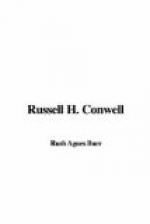No hard benches, no air of cold dreariness marks The Temple. The exterior is beautiful and graceful in design, the interior cheery and homelike in furnishing.
The building is of hewn stone, with a frontage on Broad Street of one hundred and seven feet, a depth on Berks Street of one hundred and fifty feet, a height of ninety feet. On the front is a beautiful half rose window of rich stained glass, and on the Berks Street side a number of smaller memorial windows, each depicting some beautiful Biblical scene or thought. Above the rose window on the front is a small iron balcony on which on special occasions, and at midnight on Christmas, New Year’s Eve and Easter, the church orchestra and choir play sacred melodies and sing hymns, filling the midnight hour with melody and delighting thousands who gather to hear it.
The auditorium of The Temple has the largest seating capacity among Protestant church edifices in the United States. Its original seating capacity according to the architect’s plans, was forty-two hundred opera chairs. But to secure greater comfort and safety only thirty-one hundred and thirty-five chairs were used.
Under the auditorium and below the level of the street is the part of the building called the Lower Temple. Here are Sunday School rooms, with a seating capacity of two thousand. The Sunday School room and lecture room of the Lower Temple is forty-eight by one hundred and six feet in dimensions. It also has many beautiful stained-glass windows. On the platform is a cabinet organ and a grand piano. In the rear of the lecture room is a dining-room, forty-five by forty-six feet, with a capacity for seating five hundred people. Folding tables and hundreds of chairs are stowed away in the store rooms when not in use in the great dining-room. Opening out of this room are the rooms of the Board of Trustees, the parlors and reading-rooms of the Young Men’s Association and the Young Women’s Association, and the kitchen, carving-room and cloak-room. Through the kitchen is a passageway to the engine and boiler rooms. In pantries and cupboards is an outfit of china and table cutlery sufficient to set a table for five hundred persons. The kitchen is fully equipped, with two large ranges, hot-water cylinders, sinks and drainage tanks. In the annex beyond the kitchen, a separate building contains the boilers and engine room and the electric-light plants.
The steam-heating of the building is supplied by four one hundred horse-power boilers. In the engine room are two one hundred and thirty-five horse-power engines, directly connected with dynamos having a capacity of twenty-five hundred lights, which are controlled by a switchboard in this room. The electrician is on duty every day, giving his entire time to the management of this plant. The building is also supplied with gas. Directly behind the pulpit is a small closet containing a friction wheel, by means of which, should the electric light fail for any reason, every gas jet in The Temple can be lighted from dome to basement.




